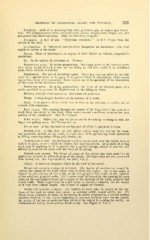Page 455 - My FlipBook
P. 455
GLOSSAEY OF TECHNICAL TERMS AND PHEASES. 303
Pyogenic. Said of a microorganism that generates pus, or causes pus forma-
tion. The staphylococcus albus, staphylococcus aureus, streptococcus longus, etc., are
pus-generating microorganisms. They are therefore pyogenic.
Pyorrhea. A flow of pus. ' ' Pyorrhea alveolaris. ' ' A flow of pus from the
alveoli of the teeth.
Quadrangle. In instrument nomenclature designates an instrument with four
angles or curves in the shank.
Range. Sizes of instruments or angles of their blades on definite comparative
gradations.
Re. In the matter of, referring to. Murray.
Resistance form. In cavity preparation; the shape given to the internal parts
of a cavity to afford such a seat for the filling as will best enable it to withstand
great stress without movement.
Resorption. The act of absorbing again. There has been an effort to use this
word in a special sense, or to apply it to special kinds of absorptions, which seems
not to have been very successful. Some writers use it in speaking of the absorption
of the roots of the deciduous teeth.
Retention form. In eavity preparation; the form of the internal parts of a
cavity provided to prevent the displacement of the filling by force.
Retzius, calcification lines of. See Lines of Accretion.
Ridge. A long-shaped elevation on the surface of a tooth.
Root. That portion of the tooth that is fixed in the alveolus, or socket, and is
covered with cementum.
Root canal. The opening through the center of the long axis of the root of a
tooth from the crown to the apex, which under normal conditions contains the root
portion of the dental pulp. Syn. Pulp Canal.
Ropy saliva. Saliva that may be drawn out in threads by touching it with the
finger and pulling away. See Viscous Saliva.
Round bur. A bur, the head or cutting part of which is spherical in form.
Rubber dam. A thin sheet of very elastic rubber used for keeping the teeth,
and especially cavities in the teeth, dry and clean while performing such operations
as filling, removing pulps, filling pulp canals, etc.
Rubber dam clamp. An instrument made to set on teeth over the rubber dam to
hold it in place, or over which the rubber dam may be thrown. It is made of spring
steel, and, in applying it, it is opened with a special forceps, placed in position and
allowed to close on the tooth with the force of its spring.
Rubber dam grasps. The forms of grasp of the rubber dam best suited to its
application to teeth in different parts of the mouth. Of these there are five, numbered
first, second, etc. See Figures 66-83, inclusive, Vol. 2.
Rugae. A series of irregular ridges in the roof of the mouth.
Rules for naming angles of cavities. (1) Angles of cavities are named by
uniting the names of the walls which meet to form the angles. (2) A line angle is
formed by the meeting of two walls, as the axio-gingival line angle, at the junction
of the axial and gingival walls. (3) A point angle is formed by the meeting of three
walls, as the axio-gingivo-buccal point angle at the junction of the axial, gingival and
buccal walls. These angles may be either sharp or smoothly rounded, but are named
as if they were definite angles. See Names of Angles of Cavities.
Rules for naming cavities. (1) Cavities in teeth take the names of the sur-
faces of the teeth in which they occur; as occlusal cavity, mesial cavity, etc. (2)
When, from extension of decay or by cutting in eavity preparation, a second surface
becomes involved, or two decays beginning in separate surfaces have become united,
the names of the two or more surfaces involved are united in naming the cavity; as
mesio-occlusal cavity, mesio-oceluso-distal cavity. See Figure 3, Vol. 2.


